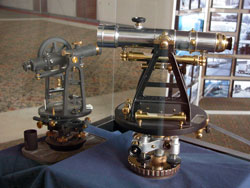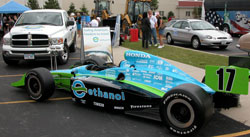 Xethanol Corporation is parthering up Global Energy and Management, LLC to develop ethanol production in New England states.
Xethanol Corporation is parthering up Global Energy and Management, LLC to develop ethanol production in New England states.
According to a press release, the new venture, known as NewEnglandXethanol LLC, or NEX, plans to open several ethanol plants throughout the region deploying Xethanol’s proprietary technologies. Additionally, Xethanol may co-locate biodiesel production in its facilities under Xethanol’s sub-license from H2Diesel, Inc.
New Fuel Frontier
Nuclear Solutions of Washington DC, “an emerging innovative technology development company,” is behind a company called Fuel Frontiers, Inc. which proposes to use commercially available and proprietary technologies to transform low-value, end-of-life carbonaceous waste materials such as waste coal, used tires, wood wastes, biomass, discarded corn stalks and other agricultural by-products, into high-value, environmentally friendly, clean-burning ethanol. They plan to base the proposed ethanol synthesis plant in Dover Township, N.J., once all the requisite hoops are jumped through. Several press releases about the company and project can be found here on the NASDAQ site for Nuclear Solutions.
Fill Up, Feel Good Podcast
 The latest “Fill Up, Feel Good” podcast from the Ethanol Promotion and Information Council is on ethanol making tracks all over the racing world. It features interviews with people who use ethanol in competition vehicles, including tractor pulls and sprint cars, as well as Indy car drivers Jeff Simmons and Danica Patrick and a guy who makes fast cars go faster on ethanol.
The latest “Fill Up, Feel Good” podcast from the Ethanol Promotion and Information Council is on ethanol making tracks all over the racing world. It features interviews with people who use ethanol in competition vehicles, including tractor pulls and sprint cars, as well as Indy car drivers Jeff Simmons and Danica Patrick and a guy who makes fast cars go faster on ethanol.
The “Fill up, Feel Good” podcast is available to download by subscription (see our sidebar link) or you can listen to it by clicking here. (4:00 MP3 File)
The Fill Up, Feel Good theme music is “Tribute to Joe Satriani” by Alan Renkl, thanks to the Podsafe Music Network.
Original Highway Equipment
 The cross country convoy is in Akron, OH and heading to Pennsylvania today. We got in too late last night to post anything although I have a lot of good stuff for you.
The cross country convoy is in Akron, OH and heading to Pennsylvania today. We got in too late last night to post anything although I have a lot of good stuff for you.
Before leaving Tinley Park, IL though we had a big press conference. The Illinois Dept. of Transportation has a very nice display of pictures of old highway construction, including equipment like this that I found fascinating.
I’ll have more tonight.
Domestic Fuel coverage and participation in the AASHTO Interstate 50th Convoy is sponsored by the Ethanol Promotion and Information Council.
Xethanol On the Defensive
 Xethanol Corporation issued a press release this week defending itself against “inaccurate and misleading statements” made in an article published by The Motley Fool on Friday, June 23. Xethanol took offense at the Fool’s suggestion that it “was formed simply to capitalize on the ethanol interest in today’s market.” To set the record straight, the release states that Xethanol was formed in 2001 with the express strategy to develop its business in the emerging biomass-to-ethanol industry. Since 2001, Xethanol has been engaged in the business of developing and operating facilities for the production of ethanol. It continues to be engaged only in that business and in the development of technologies and facilities for the production of other biofuels.
Xethanol Corporation issued a press release this week defending itself against “inaccurate and misleading statements” made in an article published by The Motley Fool on Friday, June 23. Xethanol took offense at the Fool’s suggestion that it “was formed simply to capitalize on the ethanol interest in today’s market.” To set the record straight, the release states that Xethanol was formed in 2001 with the express strategy to develop its business in the emerging biomass-to-ethanol industry. Since 2001, Xethanol has been engaged in the business of developing and operating facilities for the production of ethanol. It continues to be engaged only in that business and in the development of technologies and facilities for the production of other biofuels.
It’s worth noting that the Motely Fool did make some corrections to the article, although the general tone and the implication that Xethanol is simply “looking to exploit investor excitement for ethanol” remains. Xethanol says “the misleading statements in the article were so egregious that Xethanol felt compelled to respond.” You be the judge.
New Mexico Plant Plans
 Clovis, New Mexico is the future site of a 105 million gallon a year ethanol plant planned by private equity firms Riverstone Holdings and The Carlyle Group. According to a news release, “the plant will more than triple New Mexico’s ethanol output. New Mexico’s only other ethanol plant, Abengoa in Portales, currently produces 30 million gallons annually.” The plant will be constructed on ConAgra Trade Group’s Peavey grain elevator property which will supply corn and energy inputs for the plant, market and distribute the plant’s outputs, including ethanol and distillers grains, and provide logistics and risk management services.
Clovis, New Mexico is the future site of a 105 million gallon a year ethanol plant planned by private equity firms Riverstone Holdings and The Carlyle Group. According to a news release, “the plant will more than triple New Mexico’s ethanol output. New Mexico’s only other ethanol plant, Abengoa in Portales, currently produces 30 million gallons annually.” The plant will be constructed on ConAgra Trade Group’s Peavey grain elevator property which will supply corn and energy inputs for the plant, market and distribute the plant’s outputs, including ethanol and distillers grains, and provide logistics and risk management services.
Showcasing Ethanol Information
 On Sunday in Tinley Park, IL we set up a display with information about ethanol that used the Rahal-Letterman #17 show car. You could see it in action at last night’s race.
On Sunday in Tinley Park, IL we set up a display with information about ethanol that used the Rahal-Letterman #17 show car. You could see it in action at last night’s race.
This display was part of the Innovative Mobility Showcase that’s been following along with us at several stops to showcase some interesting highway and road safety systems.
Domestic Fuel coverage and participation in the AASHTO Interstate 50th Convoy is sponsored by the Ethanol Promotion and Information Council.
Country Coach Founder
 We are allowed to play sometimes as we trek across the United States on I-80. Here’s Bob Lee (left), founder of Country Coach, Inc. with one of the toys he brought on the trip.
We are allowed to play sometimes as we trek across the United States on I-80. Here’s Bob Lee (left), founder of Country Coach, Inc. with one of the toys he brought on the trip.
Besides a remote controlled car, Bob also brought a vintage Thunderbird and a couple of Honda tricycles. Of course he’s riding in a custom Country Coach and his toys are riding in bright yellow truck. Bob has an interesting story to tell which you can listen to here::  Bob Lee Interview (4 min MP3)
Bob Lee Interview (4 min MP3)
Here’s a short video clip of Bob playing:  Bob Lee & Toy (1 min WMV)
Bob Lee & Toy (1 min WMV)
Domestic Fuel coverage and participation in the AASHTO Interstate 50th Convoy is sponsored by the Ethanol Promotion and Information Council.
Chicago Blues
 About the only thing this post has to do with ethanol is the fact that a lot of it was being consumed around me last night at Buddy Guy’s Legends in downtown Chicago.
About the only thing this post has to do with ethanol is the fact that a lot of it was being consumed around me last night at Buddy Guy’s Legends in downtown Chicago.
I went to see the awesome blues guitarist, Carl Weathersby, who was greatly influenced growing up by Albert King. Carl was even better that I expected and I’m glad I went. After so many days on the road you need at least a few hours to unwind. However, I got a late night reminder of the challenges we face with our interstate highway system when I sat in stopped traffic coming back to my hotel. 3 lanes solid for miles after midnight due to construction. It was 30 minutes getting there, over 2 hours getting back. I’m sure the original highway planners never envisioned that kind of traffic, especially at 12:30am.
I’m posting this video clip so my convoy buddies who didn’t go, know what they missed:  Carl Weathersby (1 min WMV)
Carl Weathersby (1 min WMV)
Domestic Fuel coverage and participation in the AASHTO Interstate 50th Convoy is sponsored by the Ethanol Promotion and Information Council.
Highway Medalists
 Here is a group of medalists. Not in the Olympics but highway medals.
Here is a group of medalists. Not in the Olympics but highway medals.
The Lincoln Highway Association has produced some commemorative medals that are modern replicas of the ones made when Lt. Col. Eisenhower conducted his cross country convoy in 1919. Most of this group are folks who worked at the Ottawa AASHTO test site many years ago. They were recognized at our stop for the work they did in helping get our interstate highway system off the ground. Mixed in are current convoy participants like yours truly.
Domestic Fuel coverage and participation in the AASHTO Interstate 50th Convoy is sponsored by the Ethanol Promotion and Information Council.

